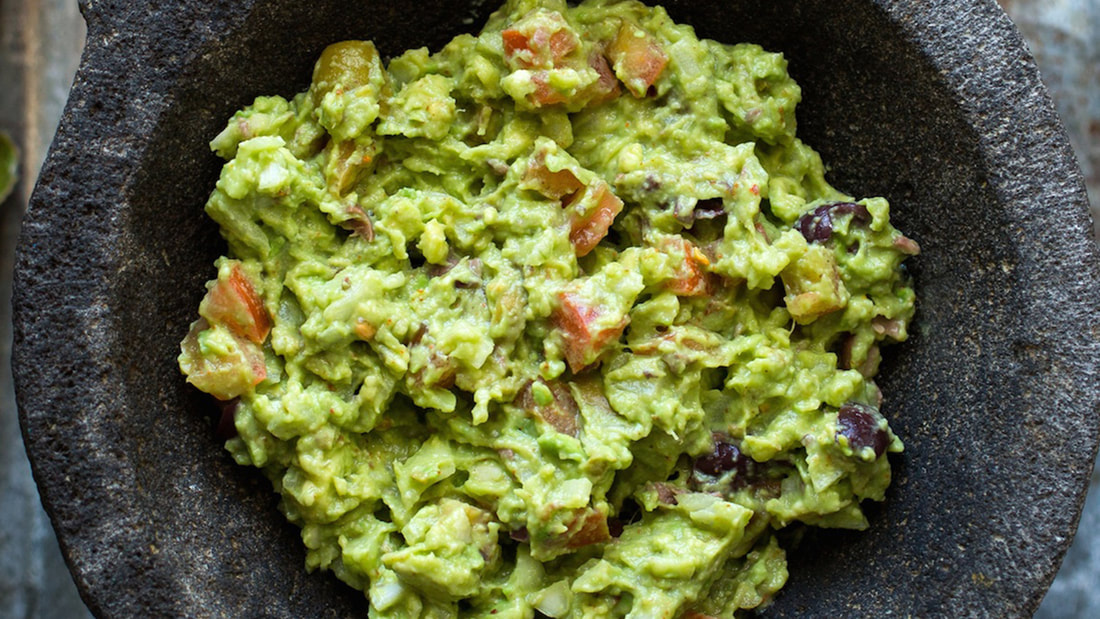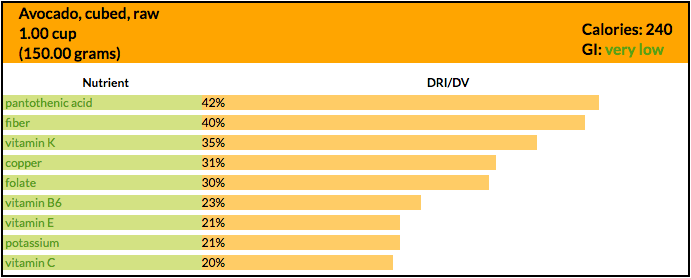|
2 servings
15 min. prep time
Tips:
0 Comments
Holy Guacamole!
4 servings 20 min. prep time
optional additions:
Tips:
Although botanically classified as a fruit, avocados are typically considered vegetables from a culinary perspective. Avocados are native to Central and South America and have been cultivated since 8,000 BC. Avocados have a smooth, buttery texture and rich, distinctive flavor, and can be enjoyed in a number of ways. Avocados are a nutrient-dense source of heart-healthy monosaturated fats, like those found in olive oil. Monosaturated fats have been observed as a staple of the Mediterranean diet, which features monosaturated-fat-rich foods such as olives, and nuts. Other healthy fats contained within avocados include phytosterols and polyhydroxylated fatty alcohols, both of which have anti-inflammatory benefits. Nutrients and Health Benefits Health-Promoting Benefits
Selecting Avocados A ripe, ready-to-eat avocado is slightly soft but should have no dark sunken spots or cracks. If the avocado has a slight neck, rather than being rounded on top, it may have ripened a bit more on the tree and have a richer flavor. A firmer, less mature, green fruit can be ripened at home and may be less likely to have bruises, depending on how it was handled during harvest and transport. The average California Hass avocado weighs between 165-170 grams (about 6 ounces) and has a pebbled dark green or black skin. As with all vegetables, it is recommended to select organically grown avocado when possible. According to EWG's analysis of tests, however, avocados are listed on the Clean Fifteen, a list of produce least likely to contain pesticide residues. Avocados have been rated as one of the safest commercial crops in terms of pesticide application, and their thick skin protects the inner fruit from pesticides. Therefore, selecting conventionally produced avocados isn't entirely inimical to one's health, although it doesn't support ethical farming practices. Storing Avocados A firm avocado will ripen in a paper bag or in a fruit basket at room temperature within a two days or so. As the fruit ripens, the skin will turn darker. However, it is not recommended to rely exclusively on color to determine the ripeness of an avocado. Hold the avocado very gently in your palm and begin to press very gently against its surface. A ripe avocado will yield to very gentle pressure, without feeling squishy. Avocados should not be refrigerated until they are ripe, or unless you are storing a large quantity of them for a period of time. Once ripe, they can be kept refrigerated for up to a week. Loss of some nutrients in avocado—for example, its vitamin C content—is likely to be slowed down through refrigeration. If you are refrigerating a whole avocado, it is best to keep it whole and not slice it in order to avoid browning that occurs when the flesh is exposed to air. If you have used a portion of a ripe avocado, it is best to store the remainder in the refrigerator. Store in a sealed and reusable glass container. Sprinkling the exposed surface(s) with lemon juice will help to prevent the browning that can occur when the flesh comes in contact with oxygen in the air. Preparing Avocados Use a stainless steel knife to cut the avocado in half lengthwise. Gently twist the two halves in opposite direction if you find the flesh clinging to the pit. Remove the pit, either with a spoon or by spearing with the tip of a knife. Next, take each of the avocado halves and slice lengthwise to produce four avocado quarters. The use the "nick and peel" method to peel the avocado. Just take your thumb and index finger to grip an edge of the avocado skin and peel it away from the flesh, in exactly the same way that you would peel a banana. The final result will be a peeled avocado that contains most of that dark green outermost flesh that is richest in carotenoid antioxidants. You can prevent the natural darkening of the avocado flesh that occurs with exposure to air by sprinkling with a little lemon juice or vinegar. Cooking Avocados Avocado should be included as an ingredient in its raw, unheated form. There simply cannot be a better way to preserve the health benefits made possible by avocado's unique fats. If you do plan to use avocado in a recipe that calls for heat, it is recommended that you use the lowest possible temperature and least amount of cooking time that will still work with your particular recipe. The purpose in making this recommendation is to help you minimize damage to avocado's unique fats. References Mateljan, G. (2018). Avocados. [online] Whfoods.com. Available at: http://whfoods.com/genpage.php?tname=foodspice&dbid=5 [Accessed 2 Apr. 2018].
Mercola.com. (2018). Avocados? - Mercola.com. [online] Available at: http://foodfacts.mercola.com/avocado.html [Accessed 17 Oct. 2017]. |
This portal contains research, news, information, observations, and ideas at the level of self in an effort to address lifestyle applications.
Archives
June 2024
Categories
All
|
||||||||||||






 RSS Feed
RSS Feed

